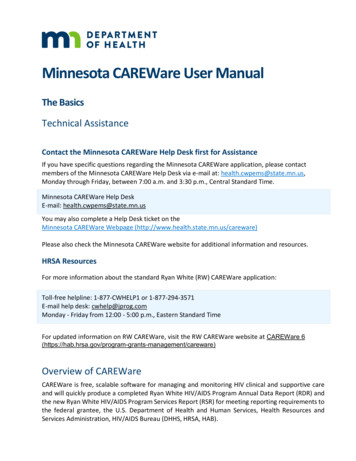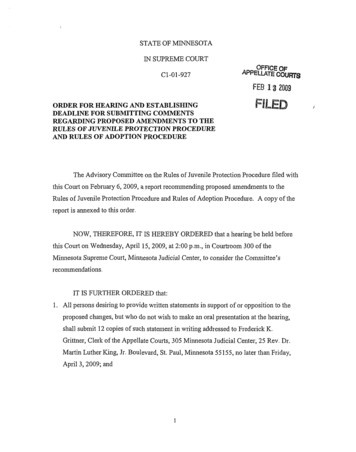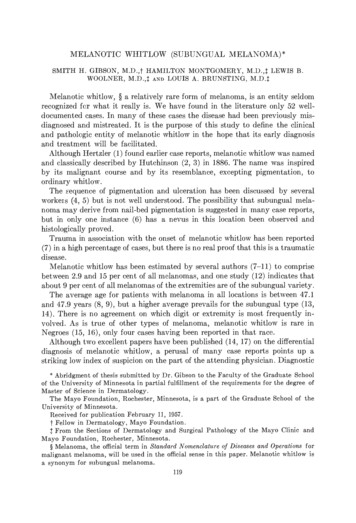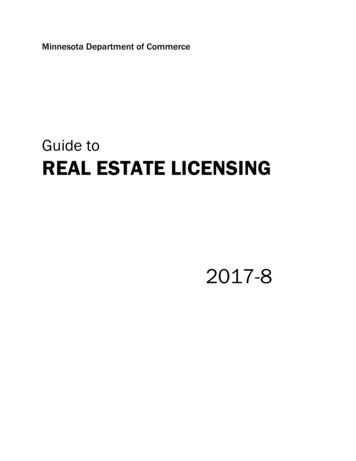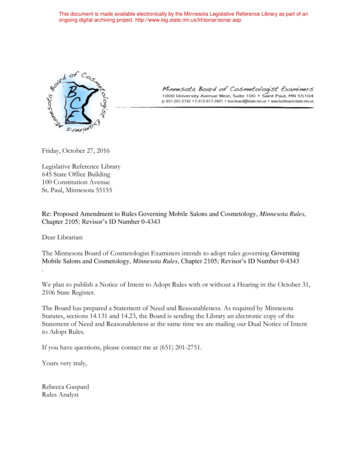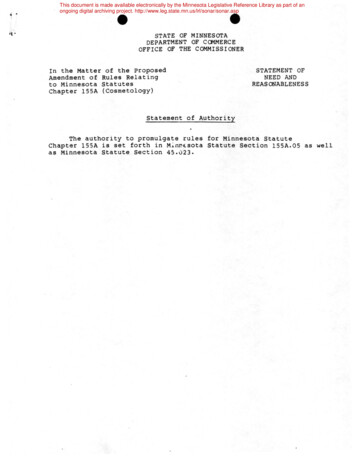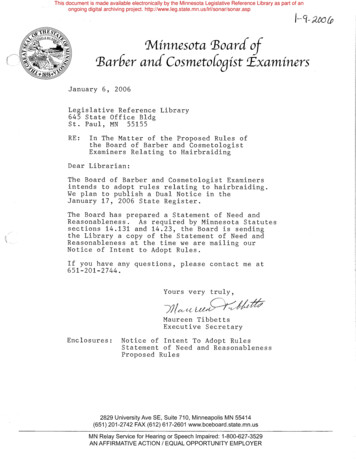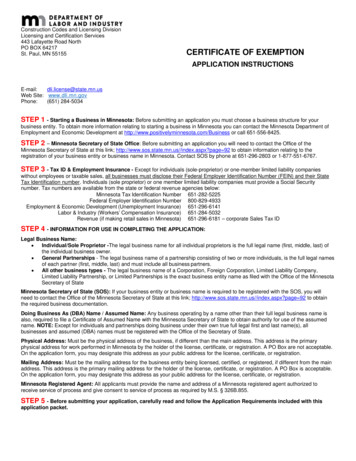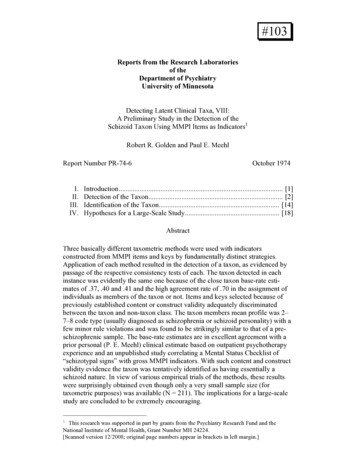
Transcription
#103Reports from the Research Laboratoriesof theDepartment of PsychiatryUniversity of MinnesotaDetecting Latent Clinical Taxa, VIII:A Preliminary Study in the Detection of theSchizoid Taxon Using MMPI Items as Indicators1Robert R. Golden and Paul E. MeehlReport Number PR-74-6I.II.III.IV.October 1974Introduction . [1]Detection of the Taxon. [2]Identification of the Taxon. [14]Hypotheses for a Large-Scale Study . [18]AbstractThree basically different taxometric methods were used with indicatorsconstructed from MMPI items and keys by fundamentally distinct strategies.Application of each method resulted in the detection of a taxon, as evidenced bypassage of the respective consistency tests of each. The taxon detected in eachinstance was evidently the same one because of the close taxon base-rate estimates of .37, .40 and .41 and the high agreement rate of .70 in the assignment ofindividuals as members of the taxon or not. Items and keys selected because ofpreviously established content or construct validity adequately discriminatedbetween the taxon and non-taxon class. The taxon members mean profile was 2–7–8 code type (usually diagnosed as schizophrenia or schizoid personality) with afew minor rule violations and was found to be strikingly similar to that of a preschizophrenic sample. The base-rate estimates are in excellent agreement with aprior personal (P. E. Meehl) clinical estimate based on outpatient psychotherapyexperience and an unpublished study correlating a Mental Status Checklist of“schizotypal signs” with gross MMPI indicators. With such content and constructvalidity evidence the taxon was tentatively identified as having essentially aschizoid nature. In view of various empirical trials of the methods, these resultswere surprisingly obtained even though only a very small sample size (fortaxometric purposes) was available (N 211). The implications for a large-scalestudy are concluded to be extremely encouraging.1This research was supported in part by grants from the Psychiatry Research Fund and theNational Institute of Mental Health, Grant Number MH 24224.[Scanned version 12/2008; original page numbers appear in brackets in left margin.]
[1][2]I. IntroductionThe substantive problem which initially provided interest in thedevelopment and testing of taxometric theories was that concerning thehypothesized schizotype taxon (see Meehl, 1962). Even though according totheory the etiological nature of the taxon is a genetic one, the variables used inthis study (MMPI items and keys) were regarded as highly fallible phenotypicindicators. The fact that these phenotypic variables are far removed causally fromthe hypothesized dichotomous genetic variable (which is of ultimate interest) andthe fact that they are influenced by and correlated with numerous nuisancevariables were both fully realized when the study was undertaken; the study wasdone in the face of these possibly fatal flaws in the design. So far, three distincttaxometric theories have been developed; they are the consistency hurdles theory(Golden et al., 1974c), the maximum covariance theory (Golden and Meehl,1974a) and the normal theory (1974b). Each theory has been tested by empiricaltrials using biological sex as the known taxonomy and MMPI items, selected todiscriminate by various degrees between the sexes and keys constructed of suchitems, as indicators. At this time, the first two theories have been studied byartificial data trials wherein a Monte Carlo method as described in Golden et al.(1974c) is used (Golden and Meehl, 1974b).Artificial and real data trials have shown that for most taxonomic detectionstudies such as with the MMPI, a sample size of about 1000 is required. Thislarge size is required mainly because of the large number of parameters whichmust be estimated. Many important questions were not answerable by this studydue to a lack of sufficient sample size. Some of these are discussed in the lastsection of this report where a large-scale study is considered.As the methods usually require sample sizes on the order of one thousand,we are in the process of constructing a huge data bank from the University ofMinnesota Hospital recorded psychiatric diagnoses, related data, and MMPI itemprotocols. Rather than wait for the completion of this time-consuming andexpensive task we decided to go ahead with a preliminary trial on a completedsub-sample even though it was of very small size (N 211). It was consideredthat if the hypothesized taxon happened to be very well defined in terms ofselected candidate indicators, then such a small sample size might prove sufficient (as shown by various male-female empirical trials of the taxometricmethods). Failure to detect a taxon could have been attributed solely to samplingerror.II. Detection of the TaxonThe sample used for the detection of the taxon consisted of 211 males withdiagnoses of neurotic, personality disorder, and transient situational disorder. Allother diagnoses (including all psychoses) were excluded to prevent the possibilityof detecting the psychotic “taxon”. The only other samples used in any of theanalyses were 96 males diagnosed as schizophrenic and the Minnesota normalmale sample. These last two samples were used for selection of the originalcandidate set of items that might discriminate between schizotypes and nonschizotypes.The consistency hurdles method requires the use of items that discriminate[3] between the to-be-detected taxon and the non-taxon class. In this method each
–2–item is subjected to consecutively applied tests which require that they haveproperties which are consistent with the other items in terms of the estimatedunderlying latent situation. When an item is not adequately consistent with theothers for a given test, then it is deleted from the analysis at that point. The MonteCarlo study of the method has indicated that the method is both powerful andunlikely to produce spurious results.As in factor analysis the output is very much dependent on the input intaxometric analysis. Required in the present study were items that were thought todiscriminate adequately between schizotypes and non-schizotypes but notbetween other possible taxa and their complementary classes. (In this regard, theselection of the sample plays a role too. For example, psychotic diagnoses werenot permitted in the detection sample as we did not want to detect the psychoticand neurotic taxa or related ones if, in fact, they do exist.) Thus, it was attemptedto select items that were ‘quasi-schizospecific’. That is, of the 550 box-formMMPI items there were only 53 which were found to discriminate betweendiagnosed schizophrenics and the Minnesota normals by a difference in the itemplus-rates of .20 or more. (Such a difference has been found to be necessary intaxometric study.) By definition, this is one necessary condition for an item to bequasi-schizospecific. Another is that the item is not correlated with dimensions ofpsychosis, severity of illness, and the like. Hence we required that an item notdiscriminate highly between subtypes of schizophrenia or between subtypes ofother psychoses. The χ2 test was used with α set at .20 since the power of χ2 isquite small with a small sample size. This procedure reduced the number of[4] candidate items to 33 (listed in Table 1).When the consistency hurdles method was applied to the 33 items, therewere 16 items (Table 2) which behaved very consistently except for excessivesampling error; that is, it appeared they would have been retained by the methodif it were not for sampling error in various calculations. Examination of Table 2shows that the items contain a moderate-to-strong degree of face validity. Whenexcessive sampling error was not allowed then the method retained 7 items andproduced the parameter estimates given in Table 3. The taxon base-rate wasestimated to be .37. The evidence at this point that a taxon does indeed existconsists solely of the Monte Carlo study of the consistency hurdles method.Although this evidence is persuasive in itself we need not be concerned with thedetails here since an abundance of other “taxon existence” evidence will be givenbelow.The parameter estimates of the seven items and the base-rate estimates wereused in Bayes’ Rule to determine the probability of taxon membership for each of211 patients. These probabilities tended to be either close to zero or close to 1.0(Figure 1) which is also indicative of a non-spurious result according to MonteCarlo study.With individuals classified as “in” or “out” of the taxon, these two groupswere treated as criterion groups. It was found that 113 of 550 items discriminatedby a difference in the plus-rates of .20 or more. A substantial number of theseitems did so simply because of sampling error, of course. Thirty items discriminated by .30 or more and were not one of the 33 first used with the consistencyhurdles method. Thus, none of these items met one or both of the requirementsfor an item to be quasi-schizospecific but they did highly discriminate
–3–[5]Table 1. Items that discriminate between diagnosed schizophrenics and normals by an item plusrate difference of .20 or more and did not discriminate between psychotic 3132(T)(F)(F)35239440633(F)71ItemDuring the past few years I have been well most of the time.At times I have fits of laughing and crying that I cannot control.I have never seen things doubled (that is, an object never looks like twoobjects to me without my being able to make it look like one object).I have never had any breaking out on my skin that has worried me.I almost never dream.I have been disappointed in love.I usually work things out for myself rather than get someone to showme how.I find it hard to set aside a task that I have undertaken, even for a shorttime.My sex life is satisfactory.In school my marks in deportment were quite regularly bad.My conduct is largely controlled by the customs of those about me.I feel that it is certainly best to keep my mouth shut when I’m introuble.If I were in trouble with several friends who were equally to blame, Iwould rather take the whole blame than to give them away.I prefer to pass by school friends, or people I know but have not seenfor a long time, unless they speak to me first.I like to be with a crowd who play jokes on one another.I enjoy many different kinds of play and recreation.I do not like to see women smoke.I am more sensitive than most other people.It is not hard for me to ask help from my friends even though I cannotreturn the favor.Even when I am with people I feel lonely much of the time.I very seldom have spells of the blues.Most of the time I feel blue.I am apt to take disappointments so keenly that I can’t put them out ofmy mind.I have not lived the right kind of life.Sometimes I become so excited that I find it hard to get to sleep.When someone says silly or ignorant things about something I knowabout, I try to set him right.I am sure I am being talked about.I tend to be on my guard with people who are somewhat more friendlythan I had expected.If given the chance I could do some things that would be of greatbenefit to the world.I have been afraid of things or people that I knew could not hurt me.I frequently ask people for advice.I have often met people who were supposed to be experts who were nobetter that I.I think a great many people exaggerate their misfortunes in order togain the sympathy and help of others.
–4–[6][7]Table 2. Items which were retained by consistency hurdle analysis not considering sampling error.Only seven of these items (see Table 3) were not finally rejected by the consistencyhurdles method but most if not all rejections were due to sampling ing the past few years I have been well most of the time.I have been disappointed in love.I usually work things out for myself rather than get someone to showme how.My sex life is satisfactory.I prefer to pass by school friends, or people I know but have not seenfor a long time, unless they speak to me first.I like to be with a crowd who play jokes on one another.I enjoy many different kinds of play and recreation.I am more sensitive than most other people.Even when I am with people I feel lonely much of the time.Most of the time I feel blue.I am apt to take disappointments so keenly that I can’t put them out ofmy mind.I have not lived the right kind of life.Sometimes I become so excited that I find it hard to get to sleep.I am sure I am being talked about.I tend to be on my guard with people who are somewhat more friendlythan I had expected.I have been afraid of things or people that I knew could not hurt me.Table 3. The final set of items retained by the consistency hurdles methodand the associated latent parameter 7(F)(F)(T)(T)(T)2020731761284ItemI have been disappointed in love.I usually work things out for myself rather than getsomeone to show me how.My sex life is satisfactory.I enjoy many different kinds of play and recreation.I am more sensitive than most other people.I have not lived the right kind of life.I am sure I am being talked about.taxon meannon-taxon class 1.165.65.34.316.75.39.367.61.32.29
–5–[8]Figure 1. Posterior probability of taxon membership using the results of theconsistency hurdles method.[9]between the taxon and non-taxon class. These 30 items are given in Table 4.Again we seem to have a moderate-to-strong degree of face validity.When the 30 Items were analyzed by the consistency hurdles method, manywere deleted because of sampling error. The method retained eight final items andestimated the base-rate to be .38, in nearly perfect agreement with the previousestimate. The two methods classify individuals as “in” or “out” of the taxon suchthat they have an agreement rate of .70. By a method developed in Golden andMeehl (1974a) the “theoretical true” misclassification rate can be estimated foreach method, the result being about .15; so the agreement rate between two suchmethods should be about .85 .85 .73. It seems that the inter-methodconcordance is in satisfactory agreement with what the separate construct validityestimates would predict.
–6–The maximum covariance and normal methods require the use of keys asindicators and employ consistency tests only once after all latent parameters havebeen estimated. Thus they require the use of indicators that adequatelydiscriminate between the taxon and the non-taxon class. It is further required thatthe indicators not correlate highly within the taxon and the non-taxon class.Finally, the normal method requires that when the indicators are keys or sums ofitems that average inter-item correlations not be high within the taxon and thenon-taxon class. The maximum covariance method requires three or moreindicators whereas the normal method can be used with any number of indicators.Three keys for use with the maximum covariance theory were constructedfrom 113 items that discriminated between the taxon, as first detected by the[10]Table 4. Items which discriminate by a difference in the item plus-rates of .30 or more betweentaxon and non-taxon class and which are not one of the original 33 quasi-schizospecificitems used with the consistency hurdles 54922354415ItemI do not tire quickly.I believe I am no more nervous than most others.I think that I feel more intensely than most people do.There is something wrong with my mind.I have had no difficulty in keeping my balance when walking.I wake up fresh and rested most mornings.My sleep is fitful and disturbed.I refuse to play some games because I am not good at them.I am easily embarrassed.What others think of me does not bother me.Criticism or scolding hurts me terribly.I am usually calm and not easily upset.My daily life is full of things that keep me interested.I brood a great deal.My feelings are not easily hurt.I feel anxiety about something or someone almost all the time.Several times a week I feel as if something dreadful is about tohappen.I have certainly had more than my share of things to worry about.I am happy most of the time.I am afraid when I look down from a high place.I have no dread of going into a room by myself where other peoplehave already gathered and are talking.My plans have frequently seemed so full of difficulties that I have hadto give them up.It makes me feel like a failure when I hear of the success of someone Iknow well.I am inclined to take things hard.Life is a strain for me much of the time.At times I think I am no good at all.I shrink from facing a crisis or difficulty.I very much like hunting.I feel tired a good deal of the time.Once in a while I think of things too bad to talk about.* Items retained by consistency hurdles method
–7–consistency hurdles method, and non-taxon class by a difference in the item plusrates of .20 or more. Factor analysis (varimax rotation) of the 113 items for thecompound sample produced three factors. The twenty highest loading items fromeach factor were selected to form the three keys. When the three keys were usedas indicators in the maximum covariance method, the results of one key did notpass the consistency test; the other two keys did so, but just barely, producingtaxon base-rate estimates of .40 and .42 which agree well with the consistencyhurdles results. On the latter two keys the difference in the latent means wasestimated to be about one within-sigma unit apart, which means themisclassification rate is about .20, a bit higher than was obtained by theconsistency hurdles method and barely low enough for the maximum covariancemethod to work adequately.The maximum covariance theory includes consistency tests which aredesigned to detect a spuriously detected taxon and inaccurate parameterestimation. Thus, to the extent that they work correctly, and the evidence is thatthey nearly always do (see Golden and Meehl, 1974b), we have further supportfor the existence of a taxon.Factor analysis of the standard MMPI keys for the compound sampleproduce a varimax factor that accounted for 40.8% of the common variance andcorrelated very highly with the psychasthenia (Pt) (.69), schizophrenia (Sc) (.53),depression (D) (.61), and social introversion (Si) (.79) scales with all otherloadings between .3 except for defensiveness (K) (–.43). The items of these fourscales were combined to make a long key to be used as a single indicator forapplication of the normal method. Intervals were constructed so that a sufficient[12] frequency appeared in each of the central ones (see Figure 2). The fact that thedistribution is skewed allows for the possibility that the frequency curve can beexplained in terms of two latent normal components. The taxon base-rate wasestimated to be .41. The chi-square goodness-of-fit statistic was only 2.3, which iswell below the expected value. The difference between the latent means was estimated to be about two within taxon sigma units.While the seven items provided for taxon identification in that they werequasi-schizospecific it is interesting that a seven item key correlated .95 with theBayes’ probability of taxon membership and .82 with the sum of four standardMMPI scales. Since the latter value is near the limit imposed by the imperfectreliabilities of the two keys (especially the seven item one), it would appear that,in practice, the four-key-sum indicator will work quite well if not as well as anyother method using the MMPI. This possibility would allow for replication inmany samples where only the scale scores are recorded; this is fortunate as it iscommon practice not to record item responses.All of the four detection methods described above classified individuals “in”or “out” of the taxon with agreement rates (for pairs of methods) very near whatthey should be as estimated from the theoretical construct validitymisclassification rates. Thus, it was concluded that a taxon does exist since thethree methods, though based on quite different assumptions, using three sets ofindicators, and developed in completely different ways agree nearly to themaximum possible extent in classifying individuals. The common base-rateestimates are remarkably close to each other and to a personal clinical estimate of.40 to .45 (P. E. Meehl). This base-rate estimate was a pre-recorded[11]
–8–[13]
–9–[14]“impressionistic guess” based on some 30 years of outpatient private practice,corroborated by an unpublished study of Meehl’s therapy cases in which anMMPI index (Sc – Es) was cut so as to correlate maximally with the schizoidscore on Meehl’s Checklist of Schizotypal Signs.III. Identification of the TaxonThe two classification groups yielded by Bayes’ Rule and the seven coreitems were compared in various ways.Independent of this study 124 items had earlier been selected on clinicalexperience grounds as probably having face validity for discriminating the taxonfrom the non-taxon class. Comparing the two classification groups on these itemsrevealed that 108 items showed a plus-rate difference in the anticipated direction,the average difference being about .2.When the two groups were compared on the standard keys those classifiedas taxon members had higher means on all the ten standard MMPI scales. Thelargest difference was on scale 7 (about 1 and 1/3 within taxon sigma units),followed by scales 1, 5, 6, 8 and 0 (1 sigma), and then by scales 2, 3 and 9 (about1/2 sigma) and this would appear to provide more construct validity evidence.Both groups had approximately the same mean ages (36.0 and 35.5) and thesame distribution of diagnoses.The mean profile for the individuals classified as members of the taxon wasnearly identical to the 2–7–8 code type. Using either the Marks and Seeman rules(1963) or the Gilberstadt and Duker ones (1965) shows that the profile nearly misseson only four of the total 10 requirements (see Table 5). This result was obtained eventhough a small per cent of the individual profiles were of the 2–7–8 type.[15]Table 5. 2–7–8 profile type Marks-Seeman Rules and ourresults.Rule1.2, 7, 8 70Tpassed2.2 – 11 15Talmost passed3.2 – 8 15Tpassed4.7 – 4 10Talmost passed5.7 – 6 10Tpassed6.7 8passed7.7&8 1&3passed8.9 70Tpassed9.0 70Talmost passedL & K 70, F 80Tpassed10.
–10–Table 5′. 278(401356) profile type Gilberstadt and DukerRules and our results.Rule1D, Pt, Sc 70Tpassed2D – Sc 15Tpassed3 Pt – Sc 20Tpassed4[16]If Pt peak, includedonly if all other scalesbelow 90T and Pt not morethan 5T greater than Dpassed5Si Maalmost passed6Ma 70Tpassed7D – Hs 10Tpassed8Pa 80TpassedThese findings are consistent with those of Goldberg (1972) who showed that themean profile of a homogeneous group better represented the underlying pathologycommon to the individuals then did the individual profiles because of inherentunreliability of the latter. Suffice it to say here that the 2–7–8 code type is the onewhich was regarded to be closest to that of the schizotype by the present investigators.A study by Briggs et al. (1966) showed that for 2,875 patients sampled fromthe same population as the present samples that less than five per cent of the totalsample had 2–7–8 profiles according to the Marks and Seeman rules even whenone rule violation was allowed. Clearly, then, the code type cannot be used verywell for diagnosis of schizotypy if the base-rate of the latter is about .40,The mean profile for those individuals classified as not members of thetaxon was considerably lower, and not at all similar to any standard code type.The main construct validity of the taxon results from the fact that the meanprofile is very similar to that of a group of pre-schizophrenics as reported byPeterson (1963) (see Figure 3). Individuals diagnosed as schizophrenic are almostcertain to be schizotypes as false-positive errors for this diagnosis are minimal.Finally, probability-of-taxon-membership correlated .56 with thepsychasthenia scale, .53 with the schizophrenia scale, .41 with the socialintroversion scale and .42 with the depression scale. These correlations are each inthe moderate range as would be expected from theory. The same variable alsocorrelated .81 with the large factor which was used to develop the single indicatorfor the normal method.
–11–
–12–[18]Another construct validation test consisted of classifying diagnosedschizophrenics, the desired outcome being that a high percentage would beclassified as taxon members. It turned out, however, that this test required theitem consistency hurdle method parameter estimates with less sampling error thanthe present sample allowed. Depending on how one adjusted for the error, thisrate varied between .35 and .85. Hence, the results of the test are inconclusive.While many further validation procedures should be used for theidentification of the taxon, and will be discussed in the next section, these appearto be all that were possible with the present data. These results are nearly ascorroborative as the available data permitted.All of the evidence as to the schizoid nature of the taxon can also be viewedas evidence for the existence of a taxon, regardless of its true nature.IV. Hypotheses for a Large-Scale Study[19][20]As mentioned above, we are in the process of assembling a very large databank which will permit further study of the existence and nature of thehypothesized taxon. With such a data bank we will have two detection samples ofsize 1000 or more which can be used for attempted replication and doublecross-validation. Because of the increased sample size and the greater amount ofinformation available on some of the patients, the completion of the data bankwill enable us to answer questions such as the following:(a) Is it possible to use such large samples in item selection, taxon detection,and the like such that complicating sampling error can be virtuallyignored?(b) Can a sample be found that allows for possible replication of the preschizophrenic finding? If so, are these individuals classified as taxonmembers at an adequately high rate both before and after the onset ofschizophrenia?(c) Is an adequately high proportion of those diagnosed as schizophrenicor schizoid personality and the like classified as taxon members?(d) Is it possible to retain about 20 items with the consistency hurdlesmethod? This number provides for an optimal key length according tounpublished Monte Carlo and empirical trials.(e) Do a relatively high proportion of the taxon members becomeschizophrenic compared to non-members? Is the rate for the nonmembers sufficiently low?(f) Is it possible to develop new keys that are discriminative and adequatelyhomogeneous for three of the four cardinal schizotypal traits: cognitiveslippage, anhedonia and social aversiveness? (The fourth, ambivalence,clearly does not have enough item representation.)(g) Do the findings replicate in general for females?(h) Is it possible to detect one or more taxa within the first order taxon?(i) Do the latent parameter estimates provide support for a singledominant gene theory of inheritance? To answer this questionrequires usage of another available twin sample. The details of thedesign of such a study will be given in a later report.(j) Do the latent parameter estimates provide for validity generalization inother samples such as one consisting of patients in psychotherapy where
–13–[21][22]the schizotype checklist (Meehl, 1973) has been completed? Do the twopsychometric diagnoses agree for a high enough proportion of thepatients?(k) Can item selection methods be used to develop keys to improve the fit ofthe maximum covariance theory?(l) Are the items and keys used to detect the taxon the best ones to use to usefor classification of individuals? That is, are indicators which are quasischizospecific also the most discriminative? Which method ofclassification is optimal?(m) What is the test-retest reliability in the diagnosis of taxon membership ornon-membership: (1) for various lengths of time, (2) for various situationvariables such as inpatient vs. outpatient, length of hospitalization and thelike, (3) for various subgroups such as male vs. female, (4) for various agegroups, and (5) for different kinds of clinical diagnosis?(n) How is the validity (as determined from the latent parameters) of thetaxometric diagnosis influenced by various imperfect reliabilities withrespect to time lapse, situation and the like as in (m) above?(o) Can the results of various methods be somehow combined to producesignificantly greater validity?(p) Should the usual rules concerning the validity scales be used whendiagnosing taxon membership?(q) What kind of items should be included in a new version of the MMPI, thatare both highly quasi-schizospecific and discriminative?(r) Do any of the standard scales moderate the validity of thetaxometric diagnosis? Do demographic variables or certain clinicaldiagnoses do likewise?(s) Does an optimal taxometric diagnosis procedure make use of anyconfigural information? The p
to select items that were ‘quasi-schizospecific’. That is, of the 550 box-form MMPI items there were only 53 which were found to discriminate between diagnosed schizophrenics and the Minnesota normals by a difference in the item plus-rates of .20 or more. (Such a differ

